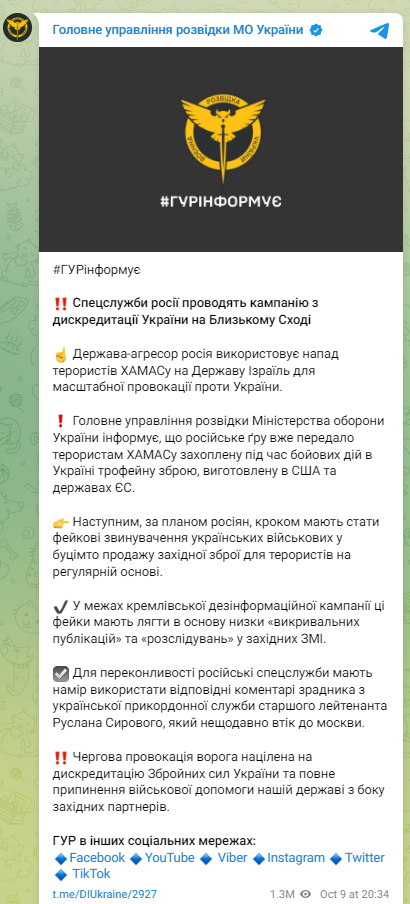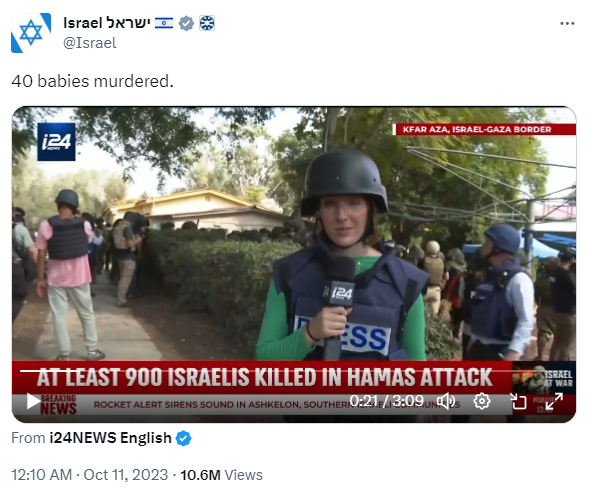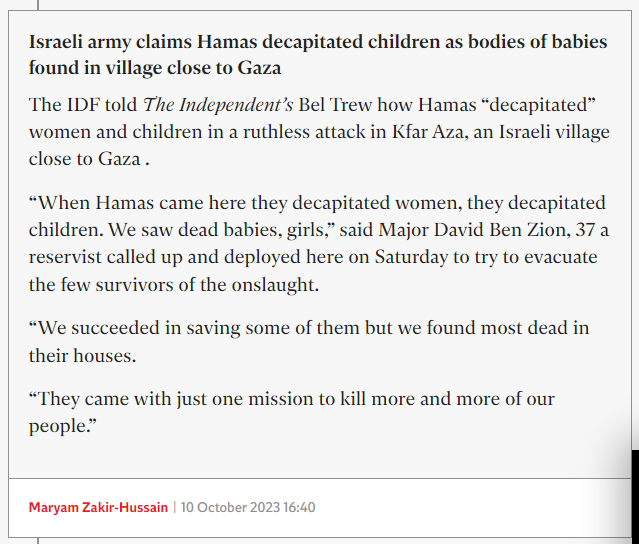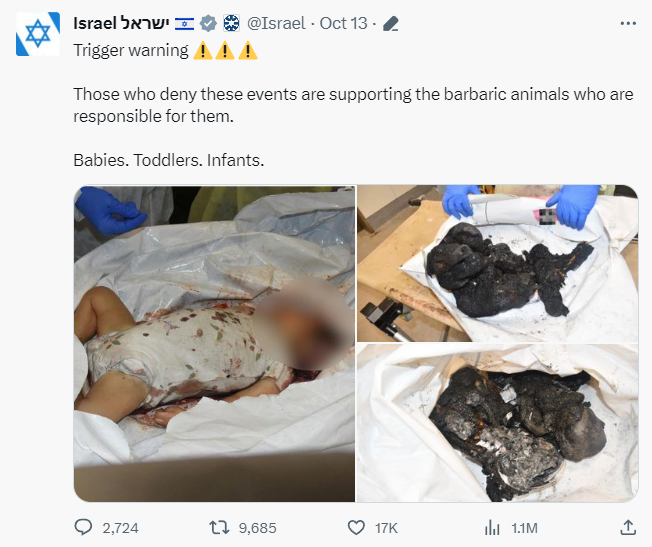In yesterday’s briefing we provided background on the terrorist attack Hamas carried out inside Israel over the weekend and on the accompanying online antisemitism and in-person antisemitism that then went viral online. Today we look at disinformation and misinformation spreading on Twitter / X during the war.
Example 1
This example has been fact-checked and debunked by Reuters. It claims to be footage of a Hamas terrorist kidnapping a Jewish child. The footage originally appeared on TikTok a month earlier on September 8th, before the current war. France 24’s “real or fake” news segment discussed the video .

While this example is fake, the kidnapping of hundreds of Israelis, including children, is very real. NBC News shared a video of a 12 year-old being kidnapped by Hamas. The New York Times interviewed a father whose wife and children, aged 3 and 5, were kidnapped. A mother told ABC news her sons, aged 12 and 16 were kidnapped while they were on the phone to her. In a media briefing IDF spokesperson Lt Col Jonathan Conricus would not say how many people exactly were behind held, but said: “I can only say that we are talking about many, many Israelis … Women, children, infants, elderly and even disabled people.”
The following tweet (see it live and share it here) shows an image of some of those who have been kidnapped:

Example 2
Another example, shown below, claims to be Israeli children behind held by Hamas in cages. Twitter notes the picture was circulating a few days before Hamas launched its terrorist attack and kidnappings. The video is again coming via TikTok. A snopes article looks at what is known about the video but agrees whatever its origin, it is not related to the current hostage situation. France 24’s “real or fake” news segment also discussed the video, noting one of those sharing it and making it go viral is the chair of the UK based far-right group Britain First. The implication is that it was being used to feed Islamophobia.

Example 3
This examples shows disinformation from pro-Russian groups seeking to use the conflict to attack Ukraine. The content, using fake BBC markings claims to be reporting on Ukraine being the source of Hamas weapons. This one goes a little deeper. As Yahoo News explains, Ukraine’s Defence Intelligence service is alleging a large scale Russian state disinformation effort which includes Russia’s military intelligence agency, the GRU, is supplying Hamas with US and EU weapons it has seized from Ukrainian forces and preparing propaganda like that shown below to claim it is Ukraine arming Hamas. The story has also been covered briefly by CNBC, which included a link to the Ukrainian Defence Intelligence service’s warning (shown below in the original and a machine translation to English).



Example 4
Multiple posts are using an article from the Turkish news site Anadolu Agency to discredit news about Hamas has murdered babies by beheading them. Some posts link to the article, others use an image of the headline.
The article itself is real, and it states: “When Anadolu contacted the Israeli army spokesperson unit over the phone and asked about the allegations, she said ‘We have seen the news, but we do not have any details or confirmation about that.’” This statement that the spokesperson has no additional information about the allegations to share at the time of the call is not news. It should have been used by Anadolu to determine if what they were hearing was credible enough to report as news, or if they should wait for confirmation to emerge.

In contrast to this report, the official Israeli Government account on Twitter / X has shared a news story from Israel’s i24 news in which the journalist says “I’m talking to some of the soldiers and they say what they’ve witnessed as they’ve been walking through these different houses, these different communities (pause) babies, their heads cut off, that’s what they said. Gunned down. Families, completely gunned down in their beds.”

The story is confirmed by The Independent in the UK who confirmed that the IDF (Israeli Defence Force) told their reporter that Hamas decapitated women and children at the Israeli village of Kfar Aza.

These accounts by individual soldiers speaking to journalists have not been officially verified by Israel in terms of the beheadings, but the fact that a number of babies were murdered in their beds has not only been confirmed, but distressing images have been released of some of them.

Returning to the Anadolu Agency article above, while it states the IDF coudl not give verification of the beheadings, it does not say anything about babies being killed. This led some who shared the article to deny the entire incident. In the mean time, this Snopes article exlplains explains that babies were killed, but that the claim of beheading is important as it provides a link to a method employed by ISIS. Personally we aren’t so sure it matters, the deliberate attack on babies and children highlights that Hamas is a terrorist organisation like ISIS, whether or not the method of killing involves beheadings.
Example 5
This example falsely alledge Israel is dropping white Phosphorus bombs, which are prohibited by international law, on Gaza. The footage which is going viral with this false claim (e.g. 1, 2, 3, 4, 5, 6, 7, 8, 9 and 10) is actually from March 2023 (see original here) and shows illegal Russian activity at it attacks Vuhledar in Ukraine with incendiary munitions.


The repurposed video is intentionally distorted (reduced clarity, zoomed in, edges blurred, cut shorter) in order to reduce automatic detection. Rather than retweet, the video has been reposted as an original tweet, with the exact same text in each case (bar one which added a translation). This looks like a cooridnated social media warfare effort.
Example 6
We are also seeking fake accounts engaging with content.


Why does this matter?
There is a disinformation war running alongside the terrorist attack, hostage taking, and the Israeli response. That disinformation war is designed to shape our perceptions, our trust in the credible media reports, our understanding of events, and ultimately our resolve to respond to this terrorism.
First, the example of the fake accounts, example 6. These are perhaps unrelated to the conflict, pure scam accounts seeking to commit fraud. Another possibility is that they are targeted, building up their network and may be infrastructure for a more serious and targeted threat in the future. Either way, inauthentic accounts pose a cybersecurity threats.
The other examples are more directly, and obviously, related to the conflict.
- Some of the disinformation is blatant and direct, take example 4 which seeks to discredit news reports.Or example 5 which seeks to spread false claims of human rights abuses by Israel, misrepresenting footage of Russian war crimes in Ukraine.
- Other examples are somewhat accurate, but use fake images / video or ones that are taken out of context. This content goes viral as an example of what is occurring, then it is debunked due to the media content. This makes those who are less informed question whether the underlying situation was real. Examples 1 and 2 do this.
- Example 3 is perhaps the most shocking. It shows evidence of Russian support of the Hamas terrorist regime, the provision of weapons, combined with a state run disinformation effort seeking to take advantage of the tragic events.
As the war progresses, the Hamas disinformation efforts are likely to intensify and become more coordinated.
Note: This article was updated 14 October.
